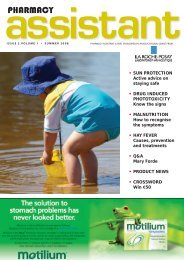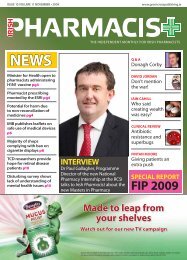veNTIlATIoN - Green Cross Publishing
veNTIlATIoN - Green Cross Publishing
veNTIlATIoN - Green Cross Publishing
You also want an ePaper? Increase the reach of your titles
YUMPU automatically turns print PDFs into web optimized ePapers that Google loves.
abstracts<br />
48<br />
first fractures among postmenopausal women with<br />
osteoporosis<br />
sontag A,<br />
Krege Jh<br />
Journal of Bone<br />
and Mineral<br />
Metabolism, 7<br />
January 2010<br />
After the occurrence of the first fracture, osteoporosis is no longer a ‘silent’ disease, and the patient’s risk for<br />
future fracture is increased several-fold. The authors from this US study from LLC, Lilly Corporate Center, Indianapolis,<br />
assessed the location of first osteoporotic fractures among women with osteoporosis.<br />
The Multiple Outcomes of Raloxifene Evaluation (MORE) trial was a fracture outcomes study of<br />
postmenopausal women with osteoporosis. All subjects received supplements containing 500mg elemental<br />
calcium and 400-600 IU vitamin D. Sontag and colleagues assessed the location of first fractures among<br />
women with osteoporosis and no previous fractures at baseline from the placebo group of this trial after three<br />
years of follow up. Prespecified fracture sites included vertebral fractures and nonvertebral fractures as defined<br />
in the MORE study protocol.<br />
Among 875 women (mean age, 64.5 +/- 7.4 years) with no prevalent vertebral or nonvertebral fractures, nine<br />
per cent experienced their first fracture event during the trial. Fractures of radius and spine each occurred in<br />
three per cent of patients. Fractures at other individual sites included ankle (0.6 per cent), metatarsal (0.6 per<br />
cent), humerus (0.5 per cent), rib (0.5 per cent), patella (0.3 per cent), leg (0.2 per cent), hip (0.2 per cent) and<br />
clavicle (0.1 per cent).<br />
These data suggest that, for postmenopausal women with osteoporosis but no previous fractures, skeletal<br />
care should include a focus on preventing spine and radius fractures.<br />
fOCUs On: WOmen’s HealTH<br />
Barriers to the use of hydrotherapy in labour<br />
stark mA,<br />
miller mg<br />
Journal of<br />
Obstetric,<br />
Gynecologic<br />
and Neonatal<br />
Nursing 2009<br />
Nov-Dec; 38<br />
(6): 667-75<br />
The objective of this US study from the Bronson School of Nursing, Western Michigan University, was to determine<br />
nurses’ perceived barriers to the use of hydrotherapy in labour. While effective in relieving pain, reducing<br />
anxiety, encouraging relaxation and promoting a sense of control, hydrotherapy is rarely used during labour.<br />
Intrapartum nurses (n=401) attending a national convention (Association of Women’s Health, Obstetric and<br />
Neonatal Nurses, 2007; n=225) and members of perinatal listserves (n=176) were recruited. A questionnaire<br />
was designed for this study (Nurses’ Perception of the Use of Hydrotherapy in Labour).<br />
Institutional but not individual characteristics (age, education and role) were associated with Nurses’<br />
Perception of the Use of Hydrotherapy in Labour. Nurses who reported higher epidural rates (r=0.45, p=0.000)<br />
and Caesarean section rates (r=0.30, p=0.000) reported more barriers. There was no difference in perception<br />
of barriers for nurses at hospitals providing different levels of care; there were significant differences when<br />
primary care providers were considered. Intrapartum nurses in facilities where certified nurse-midwives do<br />
most deliveries reported significantly fewer barriers than nurses who worked in facilities where physicians<br />
attended most deliveries (F=6.84, df=2, p=0.000).<br />
The culture of the birthing unit in which nurses provide care influences perception of barriers to the use of<br />
hydrotherapy in labour. Providing hydrotherapy requires a supportive environment, adequate nursing policies<br />
and staffing, and collaborative relationships among the healthcare team.<br />
patient perceptions of arm care and exercise advice after<br />
breast cancer surgery<br />
lee Ts,<br />
Kilbreath sl,<br />
sullivan g,<br />
refshauge<br />
Km, beith Jm<br />
Oncology<br />
Nursing Forum<br />
2010 Jan; 37<br />
(1): 85-91<br />
The purpose of this recent Australian study from the Royal North Shore Hospital, Sydney, was to describe in<br />
greater detail women’s experiences receiving advice about arm care and exercise after breast cancer treatment.<br />
A total of 175 patients with breast cancer were recruited 6-15 months after their surgery from three hospitals<br />
in the Sydney area. The patients completed a survey about their perceptions of arm activity after breast cancer<br />
and were asked to respond to an open-ended question about their experience receiving advice about arm<br />
care and exercise. Comments from 48 women (27 per cent) who volunteered responses were collated and<br />
categorised.<br />
Topics raised by respondents included perceptions of inadequate and conflicting advice, lack of<br />
acknowledgment of women’s concerns about upper limb impairments, an unsupported search for information<br />
about upper limb impairments, fear of lymphedema (also known as lymphatic obstruction), women’s demand<br />
for follow-up physiotherapy and some positive experiences with supportive care.<br />
Upper limb impairments are problematic for some breast cancer survivors and these concerns are not always<br />
taken seriously by health professionals. To date, standardised advice is provided that does not meet the needs<br />
and expectations of a cohort of women after breast cancer surgery.<br />
Health professionals could better address patients’ concerns about upper limb impairments by providing<br />
accurate advice relevant to the surgery.










